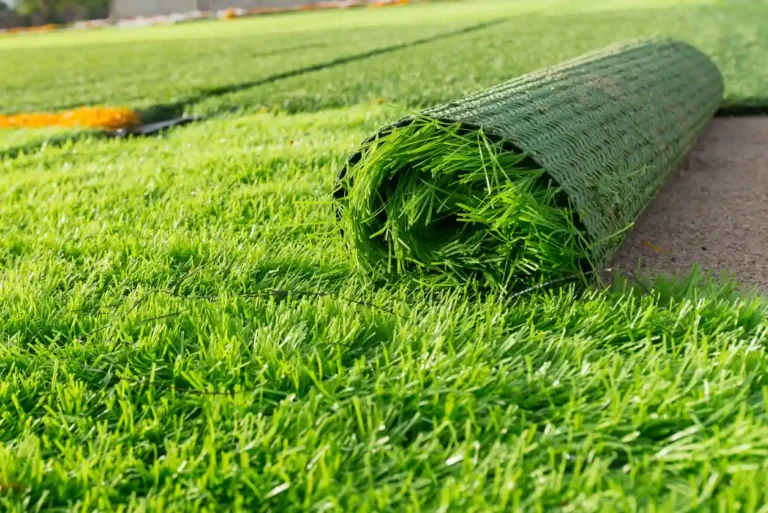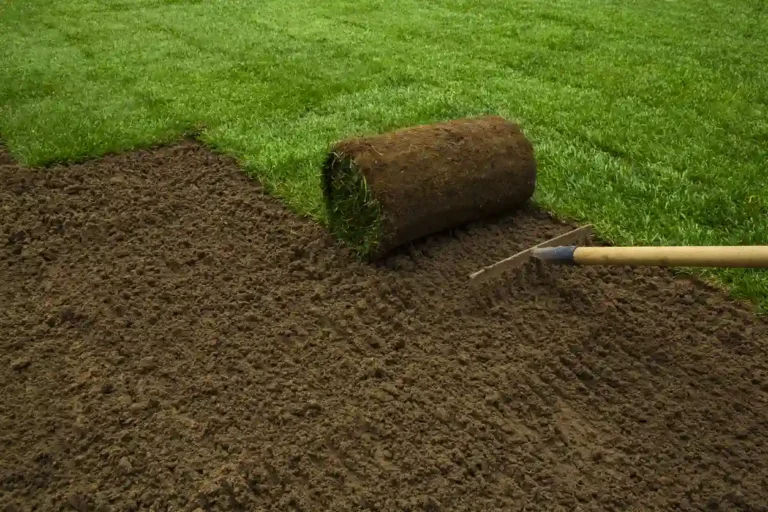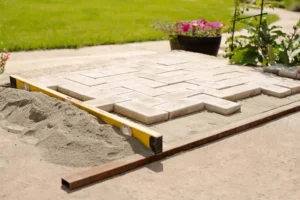Getting a new lawn with professional lawn installation can make your home look great and give you a perfect outdoor space to enjoy. Whether you choose sod, seed, or hydroseeding, picking the right grass for your area is key to a healthy lawn. Experts handle everything, from preparing the soil to laying the grass properly, so it grows strong. The cost depends on your yard size and grass type, but it’s a smart investment for a beautiful, easy-to-maintain lawn. With the right care—watering, mowing, and seasonal upkeep—you can enjoy a lush, green lawn for years.
Benefits Of Installing A New Lawn

Installing a new lawn transforms your yard into a vibrant and healthy outdoor space. Whether you’re looking to enhance the beauty of your home, improve your outdoor environment, or increase property value, lawn installation offers numerous benefits. Here’s a closer look at how a new lawn can positively impact your home and surroundings.
1. Improves Aesthetic Appeal
A well-maintained lawn instantly enhances the beauty of your property. It creates a fresh, green landscape that complements your home and surrounding plants. Whether you have a small garden or a large backyard, a lush lawn provides an inviting and visually pleasing space that makes your yard stand out.
2. Increases Property Value
A new, healthy lawn can increase the value of your home. Landscaping, especially with a beautifully installed lawn, is one of the most cost-effective ways to boost curb appeal. Potential buyers often see a well-maintained lawn as a sign of a well-kept home, which can make your property more attractive in the real estate market.
3. Supports Environmental Benefits
A new lawn offers several environmental advantages:
- Better Drainage: Grass helps absorb rainwater, reducing runoff and preventing soil erosion. This is especially important in areas prone to heavy rainfall.
- Water Management: Lawns can help manage and filter stormwater, preventing flooding in your yard and nearby areas.
- Pest Control: A healthy lawn can naturally reduce the presence of pests. Proper lawn care encourages beneficial insects while minimizing pests that may harm your garden or home.
4. Creates a Relaxing Outdoor Environment
A new lawn provides a perfect place for outdoor activities, relaxation, or family gatherings. Whether it’s for a game of catch, lounging in the sun, or simply enjoying nature, a beautiful lawn offers a space to unwind and enjoy your outdoor surroundings. The calming effect of greenery is known to reduce stress and improve mental well-being.
5. Promotes Sustainability
Installing a new lawn can help contribute to a more sustainable environment. Grass naturally absorbs carbon dioxide and releases oxygen, which benefits the air quality around your home. It also acts as a natural air filter, trapping dust and pollutants.
Preparing for Your New Lawn Installation
Proper preparation is key to ensuring your new lawn grows strong and healthy. A well-prepared site gives your sod or grass seeds the best chance to thrive. Here’s a simple guide to help you get ready for your lawn installation.
1. Test the Soil
Before you start installing your new lawn, it’s important to know the condition of your soil. Soil testing helps you understand its nutrient levels and pH. This step ensures that the soil is right for grass growth. You can easily buy a soil test kit or send a sample to a local lab. Based on the results, you can make the necessary adjustments to improve the soil, such as adding lime to raise pH or sulfur to lower it.
2. Add Soil Amendments
Once you have your soil test results, it’s time to improve the soil. If your soil is too compacted, you may need to add organic matter like compost. This will improve its texture, fertility, and ability to retain moisture. Soil amendments help provide the right environment for grass seeds or sod to grow strong and healthy. Be sure to mix the amendments well into the top few inches of soil for the best results.
3. Improve Drainage
Good drainage is essential for your new lawn. If water collects in certain spots, it could lead to root rot or uneven growth. You may need to level the ground or add sand or organic matter in areas where the water doesn’t drain properly. Proper drainage will keep your lawn healthy and ensure that water is absorbed evenly across the site.
4. Clear the Site
Before you start laying sod or seeding, clear the area of any debris, old grass, rocks, or weeds. Removing these will give your new lawn the best chance to establish itself without competition for water and nutrients. For large areas, you might consider renting equipment like a sod cutter to make the process easier. A clean, clear site helps ensure that your sod or seeds make proper contact with the soil.
5. Grade the Soil
Grading is the process of leveling your soil to ensure proper water flow and a smooth surface for sod or seed installation. Use a rake to even out the soil, filling in low spots and smoothing out high areas. A level site allows for uniform seed distribution or even sod placement, helping your new lawn grow evenly and avoid water pooling in certain areas.
The Installation Process of Lawn Installation
Installing a new lawn is a rewarding project that can transform your outdoor space. The process typically involves preparing the soil, selecting the right grass, and using the appropriate method for installation. Whether you’re laying sod or using hydroseeding, following the correct steps ensures a healthy, vibrant lawn. Here’s a simple breakdown of the lawn installation process.
1. Prepare the Soil
Before you begin any lawn installation, the first and most crucial step is preparing the soil. This includes clearing the area of any debris, rocks, or weeds. It’s important to test the soil to check its pH and nutrient levels. Based on the results, you may need to add amendments like compost or lime to improve soil fertility. After preparing the soil, level the surface to ensure a smooth, even area for the sod or seeds.
2. Choose the Right Grass Type
Selecting the right grass for your climate and soil is essential for a successful lawn. Cool-season grasses, like Kentucky bluegrass or fescue, are best for cooler climates, while warm-season grasses like Bermuda or zoysia thrive in warmer regions. Consider factors such as sun exposure, foot traffic, and the overall growing conditions of your area when choosing the best grass variety for your lawn.
3. Laying Sod or Seeding
Once the soil is prepared and the grass type is chosen, you’re ready to start the installation process.
- Laying Sod: Sod is a great option for instant results. Lay the sod pieces in a brick-like pattern, ensuring the edges are tightly fitted together. Press down the edges to remove air pockets and ensure good soil contact for root establishment.
- Seeding: If you’re seeding your lawn, use a broadcast spreader to evenly distribute the seed across the soil. Lightly rake the soil afterward to help the seeds make good contact with the soil. Be sure to follow the recommended seed rate for your grass type.
4. Watering and Fertilization
Proper watering is essential for new grass to establish strong roots. Immediately after installation, water the lawn thoroughly to ensure the soil is moist. For the first few weeks, water frequently, about 2-3 times a day, to keep the soil consistently moist. As the grass begins to grow, reduce the frequency of watering but increase the depth to encourage deeper root growth.
Fertilization is also important. About 3-4 weeks after installation, apply a balanced starter fertilizer to give your new lawn the nutrients it needs for healthy growth. Follow the manufacturer’s guidelines on the fertilizer package to avoid over-fertilizing.
5. Soil Aeration
Soil aeration is a technique that helps improve water and nutrient penetration into the soil. After the grass has started growing, aerating your lawn helps promote strong root development and overall lawn health. You can rent an aerator or hire a professional to perform this task.
6. Consider Professional Lawn Installation
While DIY lawn installation is possible, hiring a professional like Lakota Design Group can make the process easier and more efficient. Lawn installation experts have the tools and knowledge to handle the entire process, from soil preparation to proper grass selection. They can also ensure that your sod or seed is installed correctly, giving you a seamless, stress-free experience.
Best Practices for New Lawn Care

New lawns need regular attention to grow strong and healthy. Proper care helps your grass establish deep roots and become resilient to pests, diseases, and environmental stress. Below are some best practices to ensure your lawn flourishes after installation.
1. Watering Your New Lawn
Proper watering is one of the most important steps in caring for a new lawn. After lawn installation, it’s crucial to keep the soil moist for the grass to establish roots.
- Initial Watering: Immediately after installation, water the area thoroughly. For the first few weeks, water the lawn frequently, about 2-3 times a day, to keep the top layer of soil moist.
- Long-term Watering: Once the grass starts to grow, reduce the frequency of watering but increase the depth. Aim to water deeply twice a week to encourage deep root growth. Watering early in the morning is ideal to reduce the risk of fungal diseases.
2. Mowing for Healthy Growth
Mowing helps your lawn grow thick and healthy, but it’s important to avoid cutting it too short, especially in the early stages. Follow these guidelines:
- Wait Before Mowing: Allow your grass to grow to about 3 inches in height before mowing for the first time.
- Mow High: When mowing, never cut more than one-third of the grass blade height. Cutting too short can weaken the grass and encourage weeds.
- Mow Regularly: Keep your lawn at a consistent height by mowing regularly. This helps maintain healthy grass and prevents overgrowth.
3. Fertilization for Strong Roots
Fertilization provides essential nutrients that promote healthy grass growth. After lawn installation, your lawn will benefit from the right type of fertilizer:
- Initial Fertilization: About 4-6 weeks after installation, apply a balanced fertilizer. Look for a slow-release fertilizer that provides a steady supply of nutrients.
- Ongoing Feeding: During the growing season, apply fertilizer every 6-8 weeks to keep your lawn lush and green. A soil test can help determine which nutrients your lawn may be lacking, allowing you to select the right fertilizer.
4. Soil Aeration for Root Health
Soil aeration improves water and nutrient penetration and reduces soil compaction. This is particularly important for new lawns, as it helps the roots establish and grow more easily.
- Aerate Early: Once your lawn is established, aerate the soil in early spring or fall to promote root growth and improve soil health.
- How to Aerate: You can rent an aerator or hire a professional. Aerating once a year is generally sufficient for most lawns, but compacted soils may require more frequent aeration.
5. Weed Control
Weeds can compete with your new grass for water and nutrients. Preventing and controlling weeds is essential for a healthy lawn.
- Pre-Emergent Herbicides: Use a pre-emergent herbicide to prevent weed seeds from germinating. Apply it in the early spring before weeds have a chance to grow.
- Post-Emergent Herbicides: If you see weeds appear after your lawn has established, use a post-emergent herbicide to treat the problem. Be cautious about using herbicides too soon, as they can damage young grass.
6. Pest Control
Pests can harm your new lawn if not controlled. Look for signs of pest activity, such as brown patches or uneven growth, and take action if needed.
- Natural Pest Control: If you prefer not to use chemical treatments, consider natural pest control options like introducing beneficial insects or using organic pesticides.
- Routine Monitoring: Regularly check your lawn for signs of pest damage and treat the affected areas promptly to prevent further damage.
7. Seasonal Lawn Care Adjustments
Your lawn’s needs may change with the seasons. Here are some important seasonal care practices:
- Spring: This is a critical time for overseeding and fertilizing. Apply a pre-emergent herbicide to control weeds and aerate the soil to relieve compaction.
- Summer: Water regularly during dry periods and avoid mowing when the grass is stressed by heat. Apply mulch to help retain moisture.
- Fall: Fall is the best time to overseed thin spots and apply fertilizer for winter recovery. Aerate if you haven’t already done so in spring.
- Winter: Reduce watering and mowing as the grass becomes dormant. Keep the lawn clear of leaves and debris to prevent mold or disease.
8. Mulching for Moisture Retention
Mulching is an easy and effective way to maintain a healthy lawn, especially during hot summer months.
- Apply Mulch: A thin layer of mulch helps retain moisture, suppress weeds, and regulate soil temperature.
- Choose the Right Mulch: Straw or grass clippings are ideal options for mulching newly installed lawns. Avoid using too much mulch, as this can smother the grass.
Maintaining Your New Lawn
Maintaining a new lawn requires consistent care to ensure it grows strong and healthy. After your lawn installation, the key steps to success include regular watering, mowing, fertilization, and weeding. Start by following a balanced watering schedule, keeping the soil consistently moist in the early stages to help the grass establish deep roots. Mowing regularly helps your grass grow thick and healthy, but avoid cutting it too short. Fertilizing with organic options supports long-term growth and soil health. Don’t forget about pest management and soil aeration, as these are essential for preventing common problems like pests or compacted soil. By investing time and effort into your lawn’s care, you’ll ensure that your sod or grass thrives throughout the seasons, providing lasting curb appeal and a beautiful outdoor space.
How to Lay Sod for Beginners
Laying sod is a simple process that provides instant results, giving you a lush lawn in no time. Start by preparing the soil for your lawn installation, clear any debris, level the surface, and make sure the soil is rich in nutrients. When laying the sod, place each piece tightly next to the other and stagger the seams like bricks for a seamless look. Press each piece down to ensure it has direct contact with the soil, which is essential for root growth. Once the sod is laid, water thoroughly to help the grass settle in. Follow a consistent watering and fertilization schedule to promote healthy growth and strong roots. With proper care, your new sod will establish itself quickly, transforming your yard into a beautiful, green space.
How to Lay Sod Over Existing Lawn
Laying sod over an existing lawn is a great way to improve the look of your yard without starting from scratch. Begin by mowing the existing grass as short as possible and removing any debris. Next, loosen the soil to create a better surface for the new sod to establish strong roots. Once the soil is prepared, lay the sod pieces, ensuring the seams overlap slightly to avoid gaps. Water the sod thoroughly after installation to help it settle and establish roots. With this approach, you can quickly rejuvenate your lawn and enjoy fresh, healthy growth without the need for a full lawn installation or replacement.
Which Type Of Lawn Is Best?
Choosing the best type of lawn depends on your local climate, soil conditions, and how you plan to use your yard. For cooler climates, cool-season grasses like Kentucky Bluegrass and fescue are ideal, as they thrive in lower temperatures. In hotter, sunnier regions, warm-season grasses like Bermuda or Zoysia are better suited for the warmer temperatures. When deciding on the best grass for your lawn installation, consider factors like drought resistance, foot traffic tolerance, and the overall look you want to achieve. Whether you go with sod or seed, selecting the right grass type ensures a healthy, beautiful lawn for years to come.
How Much Does A New Lawn Cost?
The cost of new lawn installation depends on several factors, including the size of your yard, the type of grass you choose, and whether you opt for sod or seeding. Professional lawn installation services can add to the cost, as they include site preparation, soil amendments, and sometimes the installation of an irrigation system. Sod installation tends to be more expensive because it provides immediate results, while seeding is a more affordable option, though it requires more time for the grass to establish. Keep in mind that maintenance costs, such as watering, fertilization, and mowing, should also be factored in when budgeting for your lawn installation.
Professional Installation For a Beautiful Lawn
For a hassle-free lawn installation, consider professional services like those offered by Lakota Design Group. Expert landscapers provide a full-service experience, handling everything from soil preparation and turf selection to irrigation system installation and regular maintenance. They ensure proper grading, soil contact, and site preparation, all of which are essential for creating a vibrant, healthy lawn that will thrive for years to come. With professional help, you can achieve a beautiful, sustainable lawn with ease, saving time and ensuring long-term success.
Conclusion
Transforming your yard with professional lawn installation not only enhances your home’s curb appeal but also creates a functional and relaxing outdoor space. With Bay Area landscaping, you can ensure expert guidance in choosing the right type of grass for your climate and soil, guaranteeing healthy, long-lasting growth. By working with Bay Area landscaping professionals, you benefit from proper soil preparation, grading, and expert advice that ensures a thriving lawn. While installation costs may vary depending on your yard’s size and needs, it’s an investment that provides lasting beauty and low-maintenance upkeep. With consistent care, including proper watering, mowing, and seasonal maintenance, your new lawn will flourish, offering a lush, green backdrop to enjoy for years to come.
FAQs
What is the difference between sod and seeding for lawn installation?
Sod provides instant results by laying pre-grown grass, whereas seeding takes longer for the grass to grow but is more cost-effective. Sod is ideal for immediate coverage, while seeding requires patience as the grass establishes itself.
How do I prepare my yard for lawn installation?
Proper yard preparation includes testing and amending the soil, removing debris, leveling the ground, and ensuring good drainage. This creates the ideal environment for your new lawn to thrive.
When should I water my new lawn after installation?
Immediately after installation, water your new lawn thoroughly. For the first few weeks, water 2-3 times a day to keep the soil consistently moist. As the grass grows, reduce the frequency but increase watering depth to encourage strong root development.
How much does professional lawn installation cost?
The cost varies depending on factors like yard size, grass type, and whether you choose sod or seeding. Professional services may include soil preparation, turf selection, irrigation, and ongoing maintenance, which can impact the overall cost.
How often should I mow my new lawn?
Avoid mowing too soon after installation. Wait until the grass reaches about 3 inches in height before the first mow. Regular mowing should be done to keep the grass healthy, but avoid cutting more than one-third of the blade height to avoid stressing the lawn.
Can I lay sod over an existing lawn?
Yes, you can lay sod over an existing lawn. Start by mowing the current grass as short as possible, removing debris, and loosening the soil. Then, lay the new sod, ensuring the seams overlap slightly for a smooth, even look. This method rejuvenates your lawn without needing a complete replacement.





